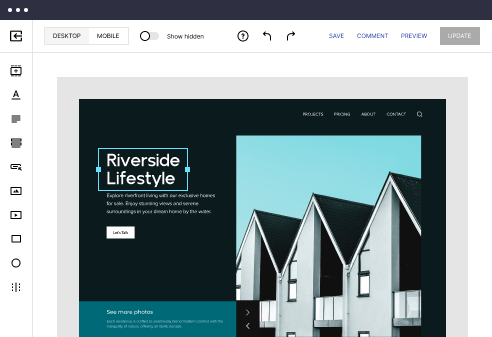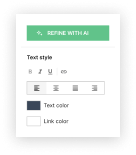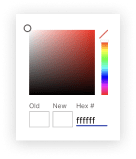
HTML page template for QA automation engineers
Use TemplateAbout template
Attract clients and showcase your skills with style using our landing page templates for QA automation engineers. Let's convert those visitors into clients!
Recommended templates
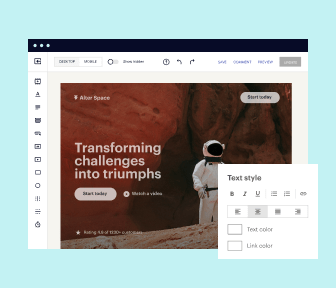
Easy to build without coding
With the intuitive drag-and-drop builder, anyone on your team can create high-converting pages without any knowledge of code or design. Make enhancements to your landing page with custom widgets using Javascript, HTML/CSS, or third-party scripts.
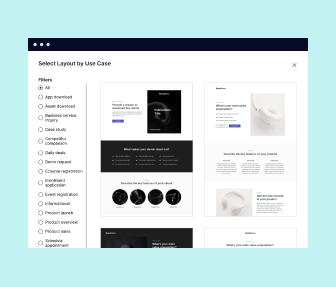
Multiple layouts for any industry and goal
Select from 500+ landing page layouts built to boost conversions across industry-specific scenarios. Customize them by adjusting fonts, adding images, and generating on-brand content with the AI assistant. Quickly scale with Instablocks® and Global Blocks that you can save, reuse, and update globally.
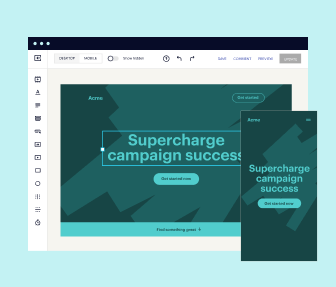
Loads fast and looks polished on any device
Every template is responsive, which means they present professionally on any device and load blazingly fast with our Thor Render Engine. You can also power them up with Google AMP technology to deliver an unparalleled mobile experience and drive higher conversions.
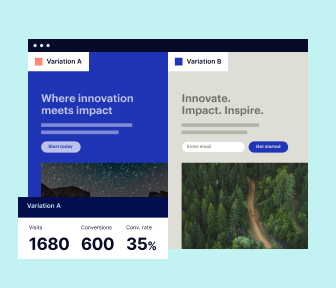
Robust analytics & experimentation
Get real-time updates and reporting across all your devices, showing the number of visitors, conversions, cost-per-visitor, and cost-per-lead. Launch AI-powered experiments, run A/B tests, and use heatmaps to analyze user behavior, then optimize your landing page to maximize conversions.
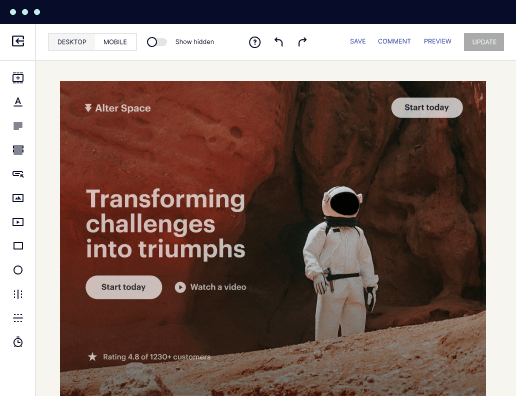
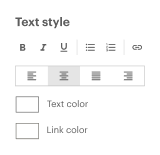
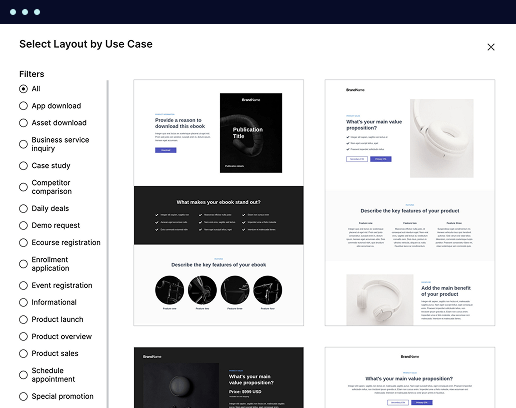
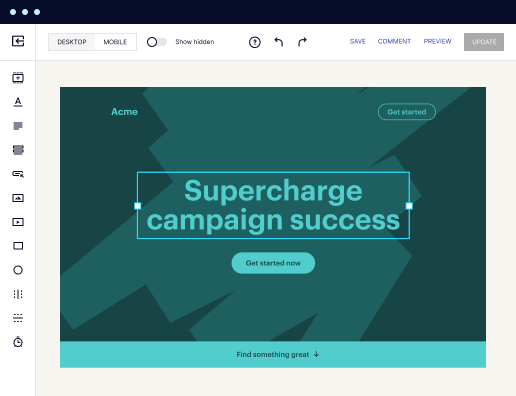
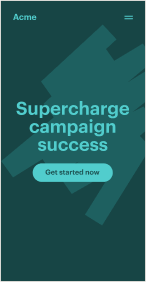
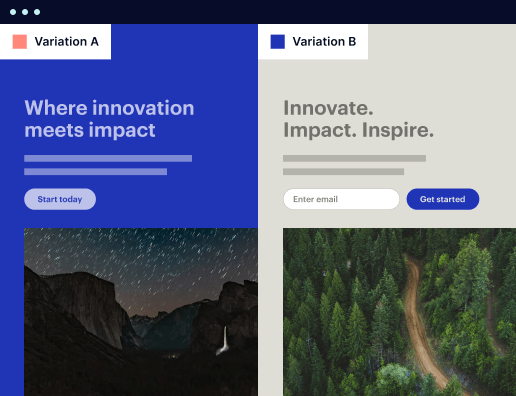
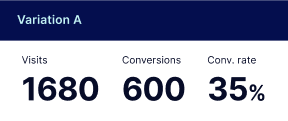
Easy to build without coding
With the intuitive drag-and-drop builder, anyone on your team can create high-converting pages without any knowledge of code or design. Make enhancements to your landing page with custom widgets using Javascript, HTML/CSS, or third-party scripts.
Multiple layouts for any industry and goal
Select from 500+ landing page layouts built to boost conversions across industry-specific scenarios. Customize them by adjusting fonts, adding images, and generating on-brand content with the AI assistant. Quickly scale with Instablocks® and Global Blocks that you can save, reuse, and update globally.
Loads fast and looks polished on any device
Every template is responsive, which means they present professionally on any device and load blazingly fast with our Thor Render Engine.
Robust analytics & experimentation
Get real-time updates and reporting across all your devices, showing the number of visitors, conversions, cost-per-visitor, and cost-per-lead. Launch AI-powered experiments, run A/B tests, and use heatmaps to analyze user behavior, then optimize your landing page to maximize conversions.
All the features you need to build lead-generating landing pages
Explore more featuresLearn how to build top-performing landing pages for any goal
FAQs
Leading the way in building high-performing landing pages





A comprehensive guide to using Instapage for your landing page and CRO needs
When it comes to creating effective landing pages and optimizing conversion rates, Instapage stands out as a powerful and versatile platform. For marketers in various sectors such as business services, education, and tech, utilizing this platform can significantly enhance campaign performance and ROI. This step-by-step guide will help you navigate through the features of Instapage, ensuring that you can make the most of your digital marketing strategies.
Understanding the basics of Instapage
Instapage empowers marketers with its all-in-one landing page creation and optimization features. It allows users to quickly build landing pages using over 100 high-converting templates and pre-built lead generation elements. By eliminating the need for coding and complex development processes, Instapage maximizes efficiency and effectiveness in campaign execution.
- Access a library of 100+ conversion-focused templates which can be easily customized to match your brand's identity.
- Utilize intuitive drag-and-drop builders to streamline the page creation process.
- Integrate lead generation elements like forms and buttons without needing previous design knowledge.
Step 1: Creating high-converting landing pages
To start building your landing page, follow these instructional steps:
- Choose a template: Start by selecting from Instapage's extensive template library that suits your marketing goal and audience.
- Customize your content: Use the intuitive editor to alter images, text, and colors that resonate with your target audience for better engagement.
- Optimize for mobile: Ensure your landing page is responsive and looks great on mobile devices since a significant portion of traffic comes from mobile.
Step 2: A/B testing for optimization
Once your landing page is live, optimizing for conversions is crucial. Instapage offers built-in experimentation features such as:
- Heatmaps: Visualize user interactions on your landing page to make data-driven decisions regarding layout and content.
- Conduct A/B tests: Test different versions of your landing page to determine which elements lead to higher conversion rates.
- Analytics dashboard: Assess performance metrics in real-time to continuously improve your campaign's effectiveness.
Step 3: Personalizing user experiences
Creating personalized content is key to engaging diverse audience segments. Here’s how you can leverage Instapage’s personalization features:
- Dynamic text replacement: Tailor messaging based on visitor data to increase relevance.
- AdMaps: Align specific ads to their corresponding landing pages for a cohesive user journey.
- Audience-level tracking: Monitor performance metrics tailored to individual audience segments for targeted improvements.
Instapage not only simplifies landing page creation but also enhances your ability to connect with your audience through robust personalization and optimization tools.
Ready to maximize your marketing ROI? Start using Instapage today and transform your landing pages into conversion powerhouses!
People also ask about HTML page template for QA automation engineers
HTML page template for QA automation engineers
Understanding the role of QA automation engineers
QA automation engineering is a crucial role in the software development lifecycle, primarily focused on creating automated tests to ensure the quality and functionality of applications. These engineers are responsible for designing and implementing testing frameworks, developing scripts for automated testing, and ensuring that products meet predefined quality standards before they are released. They possess a combination of technical skills, including proficiency in programming languages, testing methodologies, and an understanding of software development processes, which enable them to contribute effectively to the development teams.
The importance of quality assurance cannot be overstated in today’s fast-paced software development environment. Quality issues can lead to significant costs, delayed timelines, and damage to brand reputation. Thus, QA automation engineers play a pivotal role in identifying bugs early in the software development process, enabling developers to address issues before deployment, ensuring smoother operational workflows and higher customer satisfaction.
Key tools and technologies used
QA automation engineers typically leverage a variety of tools and technologies to execute their responsibilities efficiently. Commonly used automation testing frameworks include Selenium, JUnit, TestNG, and Cucumber, each of which provides unique features tailored for different testing needs. These tools facilitate automated interaction with user interfaces to validate functionalities, reducing the time and effort required for manual testing.
In addition to testing tools, programming languages also play a vital role. Java, Python, and JavaScript are among the most favored languages, with each providing robust libraries and frameworks for test automation. Understanding how to employ these technologies proficiently enables QA automation engineers to create comprehensive test suites that ensure high-quality software delivery.
The importance of an HTML page template in QA automation
HTML page templates serve as valuable assets for QA automation engineers, enhancing the reporting and visualization of test results. A well-structured HTML template can significantly improve the way testing outcomes are communicated to stakeholders, showcasing results in a clear, organized manner. By employing HTML templates, QA engineers can standardize and automate data presentation, making it easier to interpret and analyze testing results, which in turn can accelerate decision-making processes.
Moreover, consistent presentation formats help maintain professional dissemination of information. When all reports follow a uniform structure, it fosters better understanding and reduces potential confusion among team members and executives alike. This standardization allows stakeholders to quickly identify key metrics and insights, ultimately enhancing collaborative efforts across departments.
Components of an effective HTML template
An effective HTML template for QA reporting typically includes several key components. Firstly, it should feature a well-defined layout structure, including sections, headers, and footers that offer a clear hierarchy of information. For instance, headers can delineate individual test cases or results categories, while footers can provide summary statistics or disclaimers on the data's relevance.
Secondly, incorporating clear navigation aids helps users quickly access the information they need. Adding elements such as tables of contents or anchor links enables seamless navigation through extensive reports. Lastly, accessibility features are paramount. Ensuring that reports are accessible to all stakeholders, including those with disabilities, can enhance overall communication and foster inclusivity.
Features of an ideal HTML page template for QA automation
Responsive design is crucial for any HTML page template, especially for QA automation engineers who may need to present reports on various devices. Templates should be built to function seamlessly across different browsers and screen sizes, ensuring that every stakeholder can access the information no matter their device. Techniques such as CSS media queries or the flexbox layout model can be utilized to create a responsive design that adapts to diverse viewing conditions.
Furthermore, incorporating visual aids such as Gantt charts and flowcharts can provide rich contextual insight into testing timelines and workflows. Libraries like Chart.js or D3.js can be integrated to help dynamically visualize data. Effective visual representation not only makes complex data more digestible but also enhances the ability to communicate project status clearly.
Interactive data display
An ideal HTML page template further benefits from incorporating interactive elements that facilitate data display, such as charts and graphs. These features allow QA automation engineers to dynamically present automation results, showcasing key metrics like pass rates, error counts, and overall coverage visually. Accessing data from external sources for real-time analytics can significantly improve the depth of insights derived from QA reports.
Interactive dashboards can empower users to explore data more thoroughly, providing filter options and real-time updates. This capability not only helps in analyzing current test conditions but also assists in drawing comparisons with historical performance, leading to informed decision-making.
How to structure a QA report using HTML templates
Structuring a QA report using HTML templates effectively is pivotal for clear communication. Typical sections of a QA report might include an executive summary, detailed test results, defect tracking, and a comparative analysis with past project outcomes. The executive summary provides a high-level overview of the testing process and key findings, while subsequent sections offer granular insights into individual test cases, their results, and actionable recommendations.
In addition, a professional roadmap management section can be included to present key project milestones and deadlines. Visual representation of timelines helps track test progress against project schedules, ensuring timely identification of any delays or budget overruns. Leveraging AI for predictive analytics can further improve this process by offering insights into potential challenges that may affect future testing phases.
Enhancing communication with stakeholders
Effective communication with stakeholders is vital in a QA automation context. To craft thoughtful strategy proposals, it’s important to align quality assurance objectives with overarching business goals. Key components of effective strategy proposals should highlight specific quality metrics and their implications for business performance, utilizing data and reports generated from HTML templates to substantiate claims.
Moreover, utilizing presentation makers and business proposal templates can help ensure that presentations are clear and impactful. Best practices for creating compelling presentations include focusing on key findings, clearly outlining benefits, and providing data-backed insights. Formatting strategies, including visual elements within PowerPoint (PPT) presentations, can further enhance engagement and retention among audience members.
Budgeting and resource management in QA projects
Budgeting effectively for automation testing is paramount. QA automation engineers should estimate resource costs and develop strategies for budget allocation based on testing requirements. Understanding the cost implications of different testing tools and methodologies will aid in making informed decisions that ensure financial efficiency.
In addition, tools for tracking budget utilization should be implemented. Comprehensive financial reporting can help identify areas where savings may be possible, ensuring the project remains fiscally viable. A comprehensive project management dashboard can also help communicate budget status effectively, highlighting key metrics that can drive strategic adjustments.
Aligning QA automation with overall business goals
Integrating QA processes into digital transformation initiatives can significantly enhance business performance. Quality assurance supports broader corporate strategies by ensuring that software products not only meet user requirements but also align with the business’s overall objectives. Successful case studies can illustrate how thorough QA practices have led to increased product reliability and enhanced user satisfaction.
Additionally, exploring categories of QA across diverse industries highlights the need for tailored reports and templates. Industry-specific considerations such as compliance demands in cybersecurity or stringent quality requirements in the medical field necessitate customizing QA reports to address distinct business contexts, enabling a more targeted approach to quality assurance.
Elements critical for effective QA documentation
Creating standardized forms and templates for test cases is essential for maintaining effective QA documentation. Clear and concise forms foster better collaboration among team members and streamline communication regarding testing activities. A well-defined template will not only specify testing conditions but also outline procedures for documenting results, ensuring that all necessary data points are captured efficiently.
Generative reports and metrics are vital for continuous improvement in QA automation. Effective use of metrics like defect density and test coverage can provide key insights into the efficiency of testing processes. Furthermore, incorporating acknowledgement sections within reports can ensure team contributions are recognized, fostering a collaborative atmosphere in testing activities.
Best practices for maintaining and updating HTML templates
Maintaining and updating HTML templates is crucial for ensuring that they remain relevant and effective. Version control strategies can help track changes over time, allowing teams to retain core structures while incorporating new best practices. Regular updates based on feedback from stakeholders will ensure that templates evolve to meet the changing needs of the organization.
AI and automation can further streamline template management processes. Leveraging artificial intelligence for dynamic content updates allows QA engineers to pull in data automatically, reducing the manual workload associated with report creation. As trends in QA automation continue to evolve, keeping abreast of emerging technologies will enhance template customization efforts.
Bridging the gap between technical and non-technical stakeholders
Creating user-friendly documentation and training materials is essential for engaging both technical and non-technical stakeholders. Tailoring communication so that complex concepts are understandable fosters collaboration. Incorporating visuals such as organizational charts and flowcharts can help simplify intricate processes, enhancing clarity and retention.
Additionally, preparing for pitch interviews and client presentations involves approaching these engagements with a structured agenda. Providing well-prepared content that engages stakeholders on their terms can significantly enhance understanding and build trust, ultimately leading to more favorable outcomes in discussions around quality assurance initiatives.
Leveraging technology for enhanced QA processes
Using AI in automation testing can optimize testing efficiency and coverage. Through predictive analytics, AI can analyze past test data to suggest the most effective testing strategies, identify gaps in coverage, and recommend priority areas for future testing. By leveraging AI, QA automation engineers can enhance their workflows, ensuring that the processes they use are as efficient and effective as possible.
Incorporating digital marketing strategies into QA automation brings a comparative perspective on metrics and outcomes. Aligning quality assurance metrics with marketing performance can offer unique insights into operational efficiencies and customer satisfaction, yielding a more holistic understanding of a business’s performance across various domains.
Ready to skyrocket conversions?
Supercharge your ad campaigns with high-performing landing pages
Get started